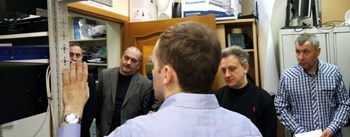
At the Kurchatov Institute in Moscow, over 50 tests have been performed on the basic I&C plant system for the divertor neutron flux monitor. Many of the functionalities of the system will serve in the development of other diagnostics plant I&C systems.
The ITER Organization will rely on over 220 plant instrumentation and control (I&C) systems to measure and control plasma parameters. Signals coming from the plant I&C systems will interface with the central ITER control system using a uniform, standardized interface "
language" and approach that has been developed by the ITER CODAC team.
Work is underway now to test plant I&C systems based on ITER CODAC technology both in a dedicated CODAC control room at the ITER site and abroad.
Last September, the ITER Organization
reported that a prototype neutron diagnostics plant instrumentation and control (I&C) system had been successfully demonstrated in manual and automated operation mode at ITER, proving that complex and high performance diagnostics can be built in compliance with the standards, specifications and interfaces defined by the CODAC team in the ITER
Plant Control Design Handbook. While the system is still incomplete in terms of functionality and number of measurement channels, it is representative of many of the functions required for operation of the Tokamak as well as required performance.
The basic plant I&C for the divertor neutron flux monitor has now been shipped to the Russian Domestic Agency in Moscow for extensive evaluation, including with actual fission chambers. Prior to the evaluation, the Russian Domestic Agency carried out site acceptance testing in the presence of colleagues from ITER—a step which also served to demonstrate the importance of site acceptance tests for all diagnostics.
During this critical phase, operators validate that the design of the delivered solution meets the diagnostics requirements for Tokamak operation; that it fully integrates with the central systems of CODAC, interlock and safety; and that it is ready for integrated commissioning in preparation for plasma operation. Site acceptance procedures also include the verification of documentation, hardware inventory, and the accessibility of software source codes.
Following the installation and configuration of the basic plant I&C for the divertor neutron flux monitor in April, a total of 50 tests were carried out to verify interfaces, system functionalities, and performance. The successful results were then presented to an audience of scientists, engineers and project managers.
Although built as a prototype I&C plant system for a neutron diagnostic, the modular software structure of the delivered solution allows its re-usability by other diagnostic systems. Functionalities such as data acquisition, timing, data processing, data archiving and real-time data publishing are common to many diagnostics, and this first prototype will serve as an excellent platform for the development of other diagnostics plant I&C systems.
Future collaboration with the Russian Domestic Agency will focus on scaling to large number of channels, interfacing with real fission detectors, and adding additional functions required for operation. To reach these goals, the teams will use collaborative tool infrastructure provided by the ITER Organization.







